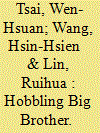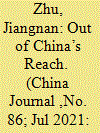|
|
|
Sort Order |
|
|
|
Items / Page
|
|
|
|
|
|
|
| Srl | Item |
| 1 |
ID:
179164


|
|
|
|
|
| Summary/Abstract |
This article argues that policy implementation in China has moved toward a system under which the center formulates a blueprint or “top-level design” from which local officials devise detailed regulations through a process of “crossing the river by feeling for stones.” This applies to the development of China’s new social credit system. To minimize political risk, when implementing it local officials have selected easier goals from the “top-level design” blueprint. In City Z, for example, we find that promoting integrity among businesses is less risky than promoting integrity among civil servants or the general public, so less progress has been made in the latter two areas when putting in place integrity credit-point systems. The risks involved in promoting social credit among the general populace are the greatest, so the city’s efforts in this have been limited. From our empirical study of China’s social credit system in City Z, we draw some conclusions about policy implementation under Xi Jinping.
|
|
|
|
|
|
|
|
|
|
|
|
|
|
|
|
| 2 |
ID:
179165


|
|
|
|
|
| Summary/Abstract |
In a context of increased state expectations that Chinese private enterprise will “give back to society,” this article argues that the way that locally developed private enterprises engage in welfare and poverty relief in rural China is decisively shaped by the social networks of the owners. Three very different industrial structures located near to each other in Fanhua County, Shandong Province, are compared. These are: a small group of large conglomerates situated near the county seat, a networked cluster of over 3,000 mostly small and micro furniture companies, and a cluster of midsize companies that produce sheet steel. Industrial structures have shaped the owners’ social networks in each of these three industries. The norms embedded in the businesspeople’s social/business networks, which are affected by the influence on the networks of political authority, factory-owner peers, and ordinary locals, orient the private enterprise owners toward providing or not providing social welfare in particular ways.
|
|
|
|
|
|
|
|
|
|
|
|
|
|
|
|
| 3 |
ID:
179166


|
|
|
|
|
| Summary/Abstract |
This article examines a paradigm shift in the PRC that has occurred over the past two decades which has transformed the meaning of “minority nationality” (shaoshu minzu). Today, the very concept of minority nationalities is perceived by Beijing as entailing a threat to the Chinese state and the Chinese nation. The shift underlies a change of China’s institutional form from a “multinational state” to a “unified community of the Chinese nation.” The result is the current heavy-handed approach toward China’s minority peoples, especially in borderlands such as Xinjiang, Tibet, and Inner Mongolia. The article suggests that these minority nationalities are now understood by the Chinese leadership to constitute veritable Frankenstein’s monsters that were created by the Party’s minority-nationality classification system and have now grown strong enough to attack their creator.
|
|
|
|
|
|
|
|
|
|
|
|
|
|
|
|
| 4 |
ID:
179169


|
|
|
|
|
| Summary/Abstract |
Individuals who take advantage of global networks to flee abroad with allegedly corrupt proceeds comprise an important yet understudied group of corruption suspects. We characterize them as “globalized corruption fugitives” and, using the case of China, investigate how they take advantage of international loopholes. Under President Xi Jinping, China actively began to pursue such suspects. Our analysis of their backgrounds and how they evade repatriation to China is based mainly on a list of China’s 100 wanted fugitives issued through Interpol Red Notices, supplemented with interviews and documentary data. We find that (1) unexpectedly, government officials did not comprise the majority in the sample; rather, state-owned companies and financial institutions, especially those based in coastal regions, seem to breed fugitive corruption suspects; (2) a tremendous amount of capital has been laundered; (3) Western countries are the most popular destinations of these fugitives, due in part to the protection against repatriation of these countries’ legal systems; and (4) Hong Kong serves as a distinct transit point for fugitives from the PRC’s justice system. This research highlights the transnational dimension of such corruption cases.
|
|
|
|
|
|
|
|
|
|
|
|
|
|
|
|
| 5 |
ID:
179168


|
|
|
|
|
| Summary/Abstract |
As services have come to account for an ever growing portion of employment in China, platform-based delivery work has grown exponentially, incorporating millions of workers. Based on a study of food-delivery company Ele.me, we first provide a detailed account of the structure of the platform-based food delivery industry, as well as worker grievances and resistance. While Ele.me workers are subjected to algorithmic control and intensive evaluation, the subcontracting structure of employment presents workers with new forms of leverage. Workers engage in quiet, small-scale, and WeChat-mediated strikes that target the subcontractors who are their direct employers, a phenomenon distinct from the occasional acts of collective resistance among food couriers in other countries. While these strikes have limitations in advancing worker interests, we show how labor unrest has emerged among such workers despite an increasingly constrained political environment and a high degree of online censorship.
|
|
|
|
|
|
|
|
|
|
|
|
|
|
|
|
|
|
|
|
|